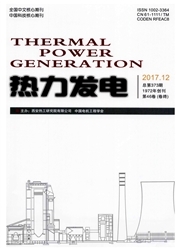

 中文摘要:
中文摘要:
针对国内引进的首台参数最高、单机容量最大的超临界600 MW机组英巴W火焰锅炉,借助1:40冷模试验台的变分级风率试验揭示其炉内气固两相流动特性,通过满负荷设计工况的工业测量获得炉内燃烧和NOx排放特性。结果表明:不同分级风率下炉内均呈现“前长后短”型偏斜气固两相流场,后墙侧下行气固两相流较快倾向炉膛中心且较早上行,上行气流整体偏向前墙侧且后拱下部形成强回流区;下行气固两相流存在气固相滑移现象且前后墙侧差异大;后墙侧燃烧状况明显优于前墙侧,前墙侧严重低温和大量未燃尽颗粒物,导致锅炉整体燃尽效果差,飞灰可燃物高达8.5%;燃烧器区域一次风粉与二次风过早混合、炉内分级燃烧程度低和后墙侧局部高温环境的综合作用,导致NOx排放质量浓度高达1 467 mg/m3(φ(O2)=6%)。建议改进炉膛结构、配风和燃烧系统,避免采用一、二次风密集相间的喷口布置方式,在构建对称燃烧流场、维持足够燃尽的同时,尽量加大炉内分级燃烧。
 英文摘要:
英文摘要:
To investigate the gas/particle flow, coal combustion and NOx emission characteristics of the firstly-imported 600 MW supercritical MBEL W-shaped flame boiler (developed by Mitsui Babcock Energy Limited Corp.), cold gas/particle flow experiments were performed within a 1:40-scaled model furnace by varying the staged-air ratio and industrial-size measurements were carried out at designed full load, respectively. The results show that, at all three staged-air ratios (even with staged-air fully closed), a deflected gas/particle flow field developed, with the downward gas/particle flow near the front wall penetrating deeper than that near the rear wall. The gas/particle flow rapidly inclined towards the furnace central part as it proceeded and therefore reversed ahead of time. The converged upward gas/particle flow deflected towards the front-half furnace zone, resulted in a strong recirculation zone appearing below the rear arch. A three-stage gas/particle slippage phenomenon developed and varied clearly between the front- and rear-half furnace parts. Increasing the stage-air ratio deteriorated the flow-field deflection.Accordingly, asymmetrical combustion appeared in the real-furnace atmosphere, where gas temperatures and combustion status were respectively higher and better in the rear-half furnace part than in the front-half furnace part. The particularly low gas temperatures and lots of unbumt coal particles in the front-half furnace part, local high- temperature zone in the rear-half furnace part, and low air-staging conditions finally generated a poor furnace performance characterized by low burnout rate (carbon in fly ash of 8.5%) and high NOx emissions (1 467 mg/m3 when φ(O2)=6%).
 同期刊论文项目
同期刊论文项目
 同项目期刊论文
同项目期刊论文
 期刊信息
期刊信息
